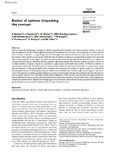| dc.contributor.author | Ronner, Esther | |
| dc.contributor.author | Sumberg, James | |
| dc.contributor.author | Glover, Dominic | |
| dc.contributor.author | Descheemaeker, Katrien | |
| dc.contributor.author | Almekinders, Conny | |
| dc.contributor.author | Haussmann, Bettina | |
| dc.contributor.author | Kuyper, Thomas | |
| dc.contributor.author | Posthumus, Helena | |
| dc.contributor.author | Ebanyat, Peter | |
| dc.contributor.author | Giller, Ken | |
| dc.date.accessioned | 2021-07-13T08:49:34Z | |
| dc.date.available | 2021-07-13T08:49:34Z | |
| dc.date.issued | 2021-07-07 | |
| dc.identifier.citation | Ronner, E.; Sumberg, J.;Glover, D.; Descheemaeker, K.; Almekinders, C.; Haussmann, B.; Kuyper, T.; Posthumus, H.; Ebanyat, P. and Giller, K. (2021). Basket of Options: Unpacking the Concept. Outlook on Agriculture, DOI: 10.1177/00307270211019427 | en |
| dc.identifier.uri | https://opendocs.ids.ac.uk/opendocs/handle/20.500.12413/16736 | |
| dc.description | Bill& Melinda Gates Foundation grant number OPP1020032, the NWO-WOTRO Strategic Partnership NL-CGIAR, and the McKnight Foundation Collaborative Crop Research Program. | en |
| dc.description.abstract | How to stimulate technological change to enhance agricultural productivity and reduce poverty remains an area of vigorous debate. In the face of heterogeneity among farm households and rural areas, one proposition is to offer potential users a ‘basket of options’ – a range of agricultural technologies from which potential users may select the ones that are best suited to their specific circumstances. While the idea of a basket of options is now generally accepted, it has attracted little critical attention. In this paper, we reflect on outstanding questions: the appropriate dimensions of a basket, its contents and how they are identified, and how a basket might be presented. We conceive a basket of options in terms of its depth (number of options related to a problem or opportunity) and breadth (the number of different problems or opportunities addressed). The dimensions of a basket should reflect the framing of the problem or opportunity at hand and the objective in offering the basket. We recognise that increasing the number of options leads to a trade-off by decreasing the fraction of those options that are relevant to an individual user. Farmers might try out, adapt or use one or more of the options in a basket, possibly leading to a process of technological change. We emphasise that the selection (or not) of specific options from the basket, and potential adaptation of the options, provide important opportunities for learning. Baskets of options can therefore be understood as important boundary concepts that invite critical engagement, comparison and discussion. Significant knowledge gaps remain, however, about the best ways to present the basket and to guide potential users to select the options that are most relevant to them. | en |
| dc.language.iso | en | en |
| dc.publisher | SAGE | en |
| dc.rights.uri | http://creativecommons.org/licenses/by/4.0/ | en |
| dc.subject | Agriculture | en |
| dc.subject | Poverty | en |
| dc.title | Basket of Options: Unpacking the Concept | en |
| dc.type | Article | en |
| dc.rights.holder | © The Author(s) 2021 | en |
| dc.identifier.externaluri | https://journals.sagepub.com/doi/full/10.1177/00307270211019427 | en |
| dc.identifier.doi | 10.1177/00307270211019427 | |
| rioxxterms.funder | Default funder | en |
| rioxxterms.identifier.project | Default project | en |
| rioxxterms.version | VoR | en |
| rioxxterms.versionofrecord | 10.1177/00307270211019427 | en |
| rioxxterms.funder.project | 9ce4e4dc-26e9-4d78-96e9-15e4dcac0642 | en |


